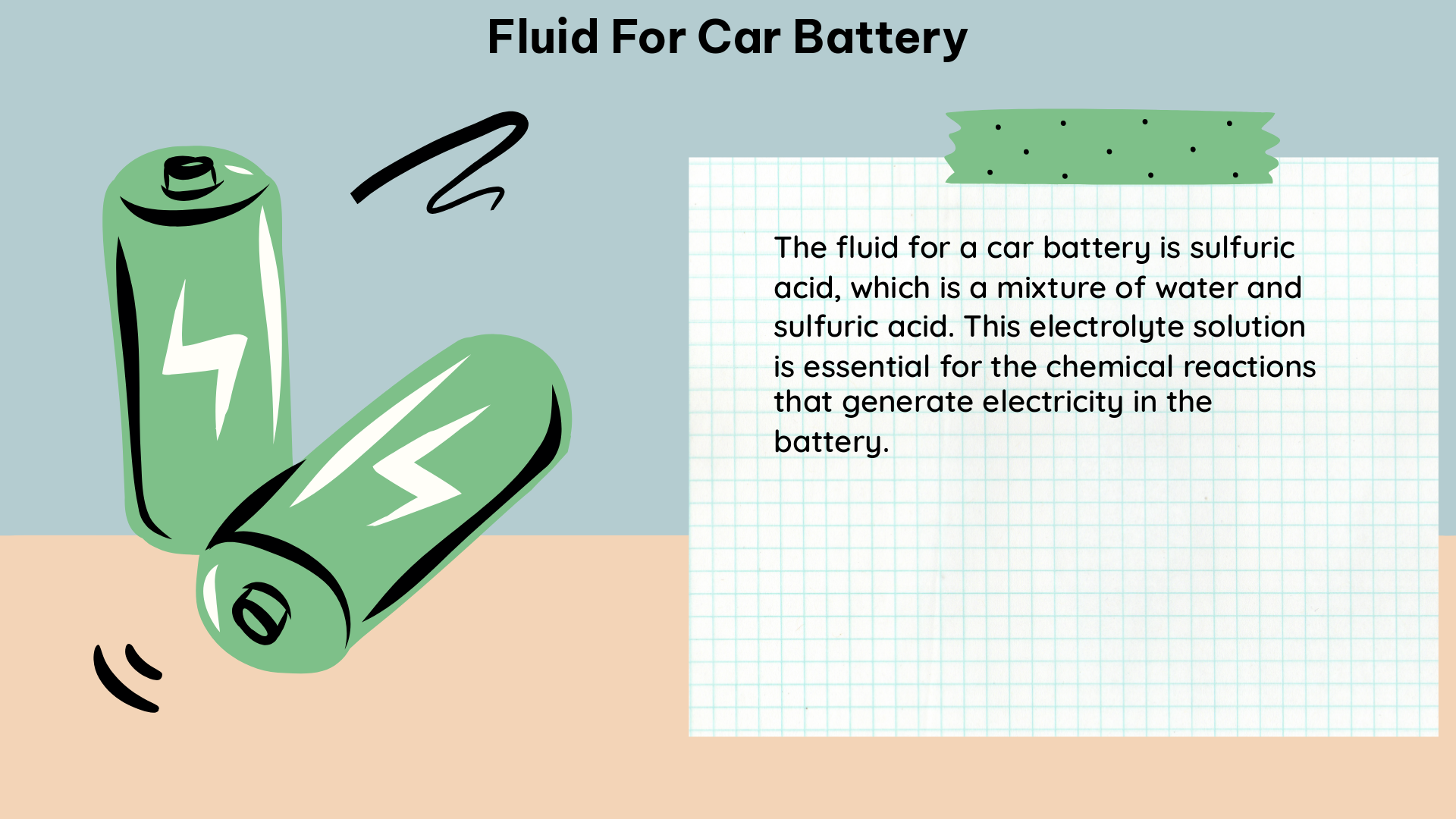The fluid in a car battery, also known as the electrolyte, is a crucial component that plays a vital role in the battery’s performance and longevity. This electrolyte is a mixture of sulfuric acid and water, and its specific gravity, or density relative to water, can be used to determine the battery’s state of charge. A higher specific gravity indicates a higher concentration of sulfuric acid, which means the battery is more charged.
Understanding the Electrolyte Composition
The electrolyte in a lead-acid car battery is typically composed of a solution of sulfuric acid (H2SO4) and water (H2O). The specific ratio of sulfuric acid to water can vary depending on the battery’s design and manufacturer, but a common composition is around 35-42% sulfuric acid and 58-65% water.
The sulfuric acid in the electrolyte plays a crucial role in the battery’s electrochemical reactions, as it helps to facilitate the flow of electrons between the positive and negative plates. As the battery discharges, the sulfuric acid reacts with the active materials on the plates, producing lead sulfate (PbSO4) and water. During the charging process, this reaction is reversed, and the sulfuric acid is regenerated.
Measuring the Specific Gravity of the Electrolyte

To determine the state of charge of a car battery, it is essential to measure the specific gravity of the electrolyte. The specific gravity is a measure of the density of the electrolyte relative to the density of water, which is typically assigned a value of 1.000 at 4°C (39.2°F).
There are two primary methods for measuring the specific gravity of the electrolyte:
-
Hydrometer: A hydrometer is a device that measures the density of a liquid by floating in it. A lead-acid battery hydrometer is specifically calibrated to measure the specific gravity of the electrolyte in a lead-acid battery. To use a hydrometer, you need to suck some of the battery acid into the hydrometer’s bulb and read the value indicated by the float.
-
Digital Density Meter: A digital density meter is a more modern and convenient way to measure the specific gravity of the electrolyte. These devices use advanced technology to provide a quick and accurate reading of the electrolyte’s density, often with the temperature-corrected value displayed on a digital screen.
When using a hydrometer or a digital density meter, it is essential to ensure that the device is calibrated for the specific temperature and electrolyte composition of the battery being measured. This is because the specific gravity of the electrolyte can be affected by temperature and the presence of other substances, such as impurities or additives.
Interpreting the Specific Gravity Readings
The specific gravity of the electrolyte can range from about 1.120 when the battery is fully discharged to 1.265 when it is fully charged. Table 3 below provides a more detailed breakdown of the relationship between the approximate state of charge, average specific gravity, and open-circuit voltage of a starter battery with antimony:
| Approximate state-of-charge | Average specific gravity | Open circuit voltage |
|---|---|---|
| 100% | 1.265 | 2.10 |
| 75% | 1.225 | 2.08 |
| 50% | 1.190 | 2.04 |
| 25% | 1.155 | 2.01 |
| 0% | 1.120 | 1.98 |
It’s important to note that these values are approximate and may vary depending on the battery’s design, age, and other factors. Additionally, the specific gravity can be affected by factors such as temperature, the presence of impurities, and the battery’s state of health.
Maintaining the Electrolyte Level
In addition to monitoring the specific gravity of the electrolyte, it is also essential to maintain the proper electrolyte level in the battery. The electrolyte level should be checked periodically, and if it is low, it should be topped up with distilled water. It is crucial to never add sulfuric acid directly to the battery, as this can disrupt the delicate balance of the electrolyte and potentially damage the battery.
Troubleshooting Common Electrolyte Issues
If the specific gravity of the electrolyte is not within the expected range, it may indicate a problem with the battery or the charging system. Some common issues and their potential causes include:
- Low specific gravity: This may be caused by a sulfated battery, a problem with the charging system, or excessive water loss due to overcharging or high temperatures.
- High specific gravity: This may be caused by overcharging, a problem with the charging system, or the addition of too much sulfuric acid.
- Uneven specific gravity: This may be caused by a problem with the battery’s internal structure, such as a cracked or warped plate, or the presence of sediment in the battery.
In such cases, it is essential to diagnose and address the underlying issue to ensure the proper functioning and longevity of the car battery.
Conclusion
The fluid in a car battery, or the electrolyte, is a crucial component that plays a vital role in the battery’s performance and longevity. By understanding the composition of the electrolyte, learning how to measure its specific gravity, and troubleshooting common issues, car owners and mechanics can ensure that their car batteries are well-maintained and functioning at their best.
References
- Measuring the Density and Specific Gravity of Battery Acid in Lead-Acid Batteries
- How to Measure State of Charge
- Using the Battery Hydrometer
- How to Check Battery Acid Levels
- How to Use a Digital Density Meter to Check Battery Acid Specific Gravity

The lambdageeks.com Core SME Team is a group of experienced subject matter experts from diverse scientific and technical fields including Physics, Chemistry, Technology,Electronics & Electrical Engineering, Automotive, Mechanical Engineering. Our team collaborates to create high-quality, well-researched articles on a wide range of science and technology topics for the lambdageeks.com website.
All Our Senior SME are having more than 7 Years of experience in the respective fields . They are either Working Industry Professionals or assocaited With different Universities. Refer Our Authors Page to get to know About our Core SMEs.